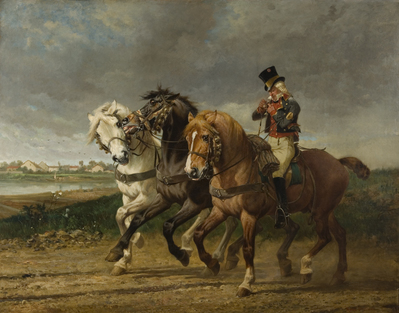The Fountain of Youth (pastel drawing for portion of the painting)
Edward Burne-Jones, Artist
See full detailsObject Detail
About the Work
“Edward
Burne-Jones
is
a
classic
late
pre-Raphaelite.
He’s
a
great
example
of
how
you
have
to
work
within
your
own
aesthetic
style.
There
is
a
lot
about
his
technique
that
is
limited
but
the
trick
all
artists
need
to
work
out
is
how
to
turn
these
limitations
as
well
as
weaknesses
into
strengths.
I
think
trends
in
painting
and
art
are
cyclical
–
based
on
class
identifications
and
signalling
as
much
as
the
aesthetic
and
artistic
content
of
the
work.
Fashion
moves
slowly
and
the
pre-Raphaelites
are
still
very
much
‘out
of
fashion’,
this
adds
an
extra
enjoyable
element
to
looking
at
them
now.”
- Andrew McLeod, 'My Choice' exhibition series, August 2022
Sir Edward Burne-Jones was a painter, illustrator and designer associated with the second phase of the Pre-Raphaelite movement. The Pre-Raphaelite Brotherhood were a group of English painters and poets who professed to see a greater sincerity in art and admired the sentimentality in the paintings found in Florence and Sienna prior to the “pompous posturing of Raphael” as found in his Transfiguration of 1520. The later phase of the Pre-Raphaelites is characterised by a dependency on obscure symbolism, as opposed to expression in art.
At Exeter College, Oxford he met fellow theology student William Morris who stimulated Burne-Jones’ interest in art. He then met Dante Gabriel Rossetti, one of the original members of the Pre-Raphaelites, to whom he became an apprentice in 1856. Among Burne-Jones's favourite subjects were graceful girls, angels, gods and heroes who all usually appear in a state of deep melancholy, thought or repose. Grace and languor, emphasised by drapery and his use of colour gives an unearthly remoteness to his paintings. He proclaimed:
“I mean by a picture a beautiful romantic dream, of something that never was, never will be – in a light better than any that ever shone – in a land no-one can define or remember, only desire – and the forms divinely beautiful.”
Although he completed some 200 oil paintings during his lifetime, Burne-Jones had a habit of returning to unfinished pictures many years afterwards. Although Fountain of Youth was begun in 1872, it did not receive Burne-Jones’ finishing touch as he deemed it too ambitious in scale. It rests here in Whanganui in a state of incompletion.
- Sarjeant Gallery exhibition label 'Leverhulme's Gifts', 2001
The drawing in the Sarjeant collection is for a portion of the planned painting. There is a preparatory watercolour of the full design in the Tate Britain collection which can be viewed at the weblink below. On the Tate Britain website it states:
According to his wife, Burne-Jones first began a large version of ‘The Fountain of Youth’ in 1873, which may be identified as this painting. The fountain of immortality was a theme he returned to several times over the years. Although the precise source of the subject is unknown, it is most probably derived from classical mythology. The Muses were thought to visit a spring on Mount Parnassis from which sprang the fountain of Castalia, the source of poetic inspiration.
- https://www.tate.org.uk/art/artworks/burne-jones-fountain-of-youth-n03428 (accessed 5/8/2022)
- Andrew McLeod, 'My Choice' exhibition series, August 2022
Sir Edward Burne-Jones was a painter, illustrator and designer associated with the second phase of the Pre-Raphaelite movement. The Pre-Raphaelite Brotherhood were a group of English painters and poets who professed to see a greater sincerity in art and admired the sentimentality in the paintings found in Florence and Sienna prior to the “pompous posturing of Raphael” as found in his Transfiguration of 1520. The later phase of the Pre-Raphaelites is characterised by a dependency on obscure symbolism, as opposed to expression in art.
At Exeter College, Oxford he met fellow theology student William Morris who stimulated Burne-Jones’ interest in art. He then met Dante Gabriel Rossetti, one of the original members of the Pre-Raphaelites, to whom he became an apprentice in 1856. Among Burne-Jones's favourite subjects were graceful girls, angels, gods and heroes who all usually appear in a state of deep melancholy, thought or repose. Grace and languor, emphasised by drapery and his use of colour gives an unearthly remoteness to his paintings. He proclaimed:
“I mean by a picture a beautiful romantic dream, of something that never was, never will be – in a light better than any that ever shone – in a land no-one can define or remember, only desire – and the forms divinely beautiful.”
Although he completed some 200 oil paintings during his lifetime, Burne-Jones had a habit of returning to unfinished pictures many years afterwards. Although Fountain of Youth was begun in 1872, it did not receive Burne-Jones’ finishing touch as he deemed it too ambitious in scale. It rests here in Whanganui in a state of incompletion.
- Sarjeant Gallery exhibition label 'Leverhulme's Gifts', 2001
The drawing in the Sarjeant collection is for a portion of the planned painting. There is a preparatory watercolour of the full design in the Tate Britain collection which can be viewed at the weblink below. On the Tate Britain website it states:
According to his wife, Burne-Jones first began a large version of ‘The Fountain of Youth’ in 1873, which may be identified as this painting. The fountain of immortality was a theme he returned to several times over the years. Although the precise source of the subject is unknown, it is most probably derived from classical mythology. The Muses were thought to visit a spring on Mount Parnassis from which sprang the fountain of Castalia, the source of poetic inspiration.
- https://www.tate.org.uk/art/artworks/burne-jones-fountain-of-youth-n03428 (accessed 5/8/2022)
Measurements
Stretcher 1596 x 1605 x 35mm
Glazing frame 1665 x 1665 x 65 mm
Frame 2020 x 1970mm
Glazing frame 1665 x 1665 x 65 mm
Frame 2020 x 1970mm
Media
chalk pastel on brown wove paper, lined onto linen, stretched over an open-backed wooden stretcher
Description
Preparatory drawing for a larger mural/fresco that was not completed. This drawing shows the right third of the planned composition. Colour chalk drawing of various figures bathing, with two central clothed figures with arms wrapped around each other standing on a rock in the water at the centre of the image.
Credit Line
Collection of the Sarjeant Gallery Te Whare o Rehua Whanganui. Gift of Lord Leverhulme, 1924
Collection Type
Permanent collection
Acquisition Date
08 Apr 1924
Share
Nationality:
Accession Number:
1924/1/5


